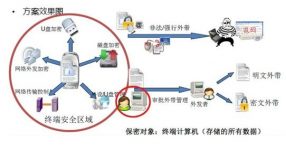
Management and Application of RFID Technology in Military Secret-related Aspects
[ad_1]
1.1 Introduction to RFID
RFID is the abbreviation of Radio Frequency IdenTIficaTIon, namely radio frequency identification, commonly known as electronic tag.
RFID technology is a non-contact automatic identification technology, which automatically recognizes the target object and obtains related data through radio frequency signals. The identification work does not require manual intervention and can work in various harsh environments. RFID technology can identify high-speed moving objects and can identify multiple tags at the same time, and the operation is quick and convenient.
1. Composition
The RFID system consists of readers, antennas, tags and application software.
2. Carrier frequency band
In practical applications of RFID technology, different carrier frequency bands are selected according to different requirements. .5 Generally, RFID carrier frequency basically has 3 ranges: low frequency (30kHz~300kHz), high frequency (3MHz~30MHz) and ultra high frequency (300MHz~3GHz). Common working frequencies include low frequency 125kHz and 134.2kHz, high frequency 13.56MHz, ultra high frequency 433Mhz, 860MHz~930MHz, 2.45GHz, etc.
1.2 Technical advantages
Before RFID technology entered the field of practical application, barcode technology assumed the main social function of item identification, and it has been widely used in the fields of commodities and logistics. However, the shortcomings of barcode technology and the advantages of RFID technology (which can be widely used in the fields of production, equipment, logistics, personnel, animals, anti-counterfeiting, positioning, etc.) have made the application fields of RFID technology continue to expand, and its trend to replace barcode technology has gradually form.
RFID technology and barcode technology have similarities in terms of purpose. Both are to quickly and accurately identify and track the target object. The main differences are as follows:
First, RFID technology can identify single and very specific objects (objects with individual characteristics), while barcode technology can only identify one type of object. That is, RFID technology can realize “similar differentiated identification”;
Second, RFID technology has the ability to identify “objects out of sight”, and barcode technology can only identify objects “in sight”;
Third, RFID technology can identify multiple objects at the same time, and barcode technology can only identify one object at a time;
Fourth, the electronic tag of RFID technology has the function of repeated use, and the barcode can only be used once;
2. Security Management of Confidential Articles
The application of RFID technology in the management of military secret-related equipment should fully reflect two points: first, safety prevention; second, safety traceability.
2.1 Application object
Secret-related computers (notebooks), secret-related hard disks, communication equipment, confidential equipment, U disks, paper-based confidential materials (documents).
2.2 Determine needs
Confidential articles or equipment involve national security, and reliable security management is an important guarantee to prevent the leakage of secrets. The application of RFID technology to the security management of classified articles or equipment is due to the inherent technical advantages of RFID technology: 1. Automatic identification; 2. Out-of-sight identification. These two characteristics of RFID technology can precisely solve two major problems in security management: 1. If you don’t find (see), you can’t stop it; 2. Manual management errors (omissions) are inevitable.
When RFID technology has established a binding relationship with each security object (computer, communication equipment, etc.), a security management system for confidential items with automatic identification, automatic tracking, automatic alarm, historical tracking, and rapid inspection functions is established. .
2.3 Realization of functions
When the safety management system of RFID technology is established, the following functions can be realized:
1. Automatic recognition
1) Confidential items contained in clothes, packages, and vehicles are automatically discovered when passing through the entrance and exit;
2) For found items, the system automatically judges whether to call the police;
2. Automatic tracking
1) After the confidential item leaves the confidential room or office, it will automatically track the moving route;
2) For the main passages (such as confidential rooms, office building entrances and exits, corridors, etc.) that confidential items pass through, the system automatically remembers the elapsed time;
3. Automatic alarm
1) The system does not issue alarm notifications for confidential goods that are allowed (or have approval procedures) to carry, and only stores the pass records for historical traceability;
2) For unauthorized confidential items, the system will issue an alarm or notification;
4. History traces
The custodians, recipients, and borrowers of confidential items are bound to the system. After an abnormality occurs, the system automatically generates records of confidential personnel and items.
5. Quick inspection
Quick inspections can be carried out for confidential items and confidential rooms with a high level of confidentiality. Realize the organic combination of technical prevention and manual prevention.
1) The system can instantly prompt whether confidential items are moved, damaged, and moved information;
2) For a confidential room that stores 100 confidential items, an inspection report can be provided within 10 seconds;
2.4 Solution
2.4.1 System Design
1. The label is installed or fixed on confidential items (computers (laptops), confidential hard drives, communication equipment, U disks, etc.).
2. Install remote identifiers in places where security rooms, offices, corridors, entrances and exits of office buildings, main roads, gates, etc. must pass through.
3. According to the setting of the management system, managers carry mobile identifiers (small display screens) to conduct quick inspections of classified articles on a regular or irregular basis.
4. Install necessary alarm equipment and set appropriate alarm notification methods.
5. Develop application software: security management system for classified articles.
2.4.2 System structure diagram

[ad_2]




